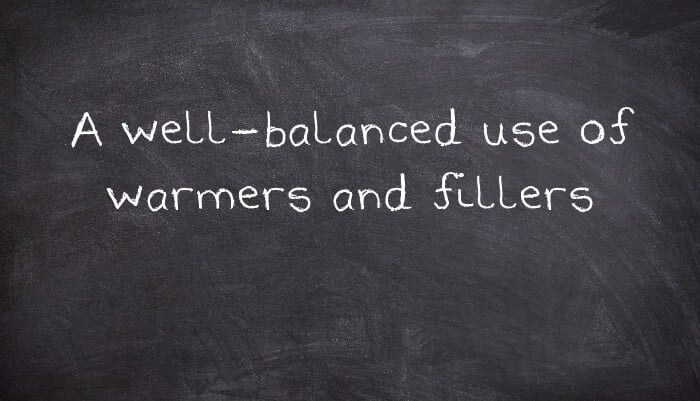A well-balanced use of warmers and fillers
Using short two to ten minute energising activities as warmers at the beginning of a lesson is a basic technique of language teaching that can make a huge difference to the atmosphere of a class, and therefore to how much students learn and how happy they are to come back to class next week. The same is true of using exercises in the middle of the class to give students a break and reenergise them. Like everything in life, though, you can have too much of a good thing. Below are some tips on checking if you have got the use of warmers and fillers just right, and what you can do about it if you haven’t.
Signs that you are using warmers too much
If any of the things below are true for you, you might want to think about cutting down the number of warmers you use or using them differently:
-
Absolutely every lesson starts with a warmer
-
Most of your warmers aren’t linked to the content of the rest of the lesson
-
Warming students up is the only justification for most of your warmers
-
You try the same warmer in every class in your schedule without thinking about the characteristics of each class
-
You try new warmers because “This is something I really want to try” rather than “This would be really good with my (Thursday afternoon) class”
-
You automatically use the warmer you have planned even when the class is already filled with energy when you walk into the room
-
There are other stages in your lesson that are more linked to the rest of the lesson that could work just as well as a warmer as the separate warmer stage you have put in
-
The students know that extending the warmer is a great way of avoiding the real work they will have to do in the rest of the lesson
-
You can’t answer if someone asks you what the warmer was for in that lesson
-
You can’t answer if someone asks you why you used the warmer or filler at that point
-
Students have got so used to warmers that they aren’t really energised by them any more
-
You have to desperately search around for new warmer ideas because your students have already used every one you know
-
Students don’t switch their brains on for the first 10 minutes of every class because they think what they do then is just a bit of irrelevant fun
-
Students have complained about too many games
-
When you are planning your lesson you decide to leave out a useful stage without thinking about whether you could take out the warmer or filler instead
Signs that you aren’t using warmers and fillers enough
-
There is no space on your lesson plan for an (optional) warmer
-
You have no idea what to do when students’ energy drops
-
The first activity of every lesson is checking the homework
-
The first activity of every lesson is at least 15 minutes long
-
The students only warm up by the midpoint of each lesson
-
Students are never surprised in your lessons
-
Your usual responses to having five minutes left are to extend the last activity or chat
-
You only have one or two warmers and fillers in your entire repertoire
-
You haven’t learnt any new warmers and fillers since your initial training course
-
The only thing stopping you from using a warmer or filler is not knowing one which will fit in with the lesson, group of students or time available that you haven’t used before
-
You just got out of the habit of using warmers and fillers, but you can’t remember why
-
You are just too nervous to try them in case students think they are stupid
-
You have never tried to use a warmer or filler
-
You have tried every other way to cope with a class with bad dynamics
-
There are no plan Bs on your lesson plan
Ways of making sure you use the right number of warmers and fillers
-
Have a space on your lesson plan for your optional fillers and warmers, and write down or think about under what circumstances you will or will not use them. Then check the rest of your lesson plan to see if any other stages that are already there could be used as a warmer or filler instead, e.g. testing each other on the answers to the homework.
-
Have a collection of at least five warmers that are on your list of things to try (but with no rush in which to do so)
-
Ask an observer or someone checking your lesson plan to concentrate on your use of warmers and fillers
-
Explain to the students why you are using each warmer or filler, therefore making its clear purpose obvious to yourself too
-
Collect lots of warmer and filler ideas and then classify them with things like “no good for teenagers”, “ties in with functional language classes” etc, perhaps writing those comments next to the ideas.
-
Add warmer ideas to your supplementary files or the ones in your teachers’ room, e.g. under each grammar point or each area of ESP.
-
Give a workshop on warmer and filler ideas, making sure people discuss how and when to use each idea rather than just saying “This is a good one”, and/ or have a notice board where people pin up their ideas with comments on each one.
